Load data from Amazon Kinesis
This topic describes how to load data from Amazon Kinesis into CelerData.
How it works
The overall solution is as follows:

- Your business application writes streaming data into a Kinesis data stream.
- You create a Kinesis Data Analytics application to read the input data from the Kinesis data stream.
- The Kinesis Data Analytics application writes data into a CelerData cluster by using the flink-connector-starrocks SDK.
Precautions
- We HIGHLY RECOMMEND you first to take the get started exercise to create a Kinesis Data Analytics application with Kinesis data streams as a source and a sink. As such, you can quickly familiarize yourself with Kinesis and solve the problems you may encounter before writing data into a CelerData cluster.
- To ensure a smooth loading operation, we recommend you to use the AWS Management Console to create Kinesis data streams and the Kinesis Data Analytics application, and use the names given in the get started exercise.
- When you configure the Kinesis Data Analytics application, pay attention to the following configurations:
- When you edit the IAM policy, make sure that you add the permissions to access the Kinesis data streams.
- When you configure the networking for your Data Analytics application, you MUST make sure the Kinesis Data Analytics application has access to the Internet by STRICTLY following the instructions in Configure the application networking.
- When you create a CelerData cluster, you need to enable SSL connection.
- After you successfully run the application and start to load data into the data stream, you can view the data in the data stream by using the Data Viewer and then check whether data is loaded into the target CelerData table.
Before you begin
Make sure the Kinesis Data Analytics application can connect to the CelerData cluster over the Internet.
Configure the networking for the CelerData cluster
-
Make sure the CelerData cluster can be connected from the Internet, especially when the CelerData cluster is in a private subnet. If the CelerData cluster is in a public subnet, the CelerData cluster can be connected over the Internet by default. This topic uses a CelerData cluster in a public subnet as an example.
-
Make sure that the security group with which the CelerData cluster resources are associated allows traffic from the Kinesis Analytics application.
-
Sign in to the CelerData Cloud BYOC console and find the Security Group ID with which the CelerData cluster is associated:

-
Sign in to the Amazon VPC console.
-
In the left-side navigation pane, choose Security Groups. Find the security group with which the CelerData cluster resources are associated.
-
On the Inbound Rules tab, choose Edit inbound rules.
-
Add the following rules highlighted in the red box:
You must add ports
443and9030.
Note
When you create a CelerData cluster, you need to enable SSL connection.
-
Configure the networking for the Kinesis Data Analytics application
Make sure the Kinesis Data Analytics application has access to the Internet when you configure the Kinesis Data Analytics application.
- If you customize the VPC for your application, the networking for the application must meet the following requirements:
- The Kinesis Data Analytics application must run in a private subnet.
- The VPC must contain a NAT gateway or instance in a public subnet.
- A route is configured for outbound traffic from the private subnet that hosts the Kinesis Data Analytics application to the public subnet that hosts the NAT gateway or instance. For more information, refer to Internet and Service Access for a VPC-connected Kinesis Data Analytics application.
- Or you can just configure the application networking as No VPC.
Basic operations
Write streaming data into Kinesis Data Stream
You can use a Kinesis Data Stream to store large streams of data records in real time.
- Create a Kinesis data stream. If you use Kinesis for the first time, we recommend you to use the same name
ExampleInputStreamas in the get started exercise. - After you successfully run the Kinesis Data Analytics application, write data to the Kinesis data stream.
Create a database and table in CelerData cluster
Create a database and a table in the CelerData cluster according to the data records in the Kinesis data stream.
CREATE DATABASE IF NOT EXISTS example_db;
USE example_db;
CREATE TABLE stock (
`EVENT_TIME` datetime NOT NULL,
`TICKER` varchar(65533) NOT NULL,
`PRICE` float NULL
) ENGINE=OLAP
DUPLICATE KEY(`EVENT_TIME`)
DISTRIBUTED BY HASH(`EVENT_TIME`) BUCKETS 2
PROPERTIES (
"replication_num" = "1"
);
Use Kinesis Data Analytics application to read data from Kinesis Data Stream and write data into CelerData
You can use a Kinesis Data Analytics application to continuously read from a data stream, process and analyze streaming data, and write into a CelerData cluster.
Edit demo code and build Kinesis Data Analytics application
The Kinesis Data Analytics application reads data from a Kinesis Data Stream and uses the flink-connector-starrocks SDK to encapsulate data into multiple parallel Stream Load jobs to load data into your CelerData cluster.
The demo code for the application mainly configures Flink job properties of a source data stream and a target CelerData cluster. Compared to the original AWS code, the demo code uses the flink-connector-starrocks dependency in the pom.xml file and configures job properties of the target CelerData cluster in the sink function.
Follow these steps to edit the demo code and build the Kinesis Data Analytics application:
-
Make sure that the environment meets the prerequisites for developing the Kinesis Data Analytics application.
-
Clone the remote repository.
git clone git@github.com:StarRocks/demo.git -
Navigate to the directory that contains BasicStreamingJob.java file. This topic uses Flink version 1.15 as an example, so you need to navigate to the directory GettingStarted.
cd ./demo/AwsDemo/amazon-kinesis-data-analytics-java-examples/GettingStarted/src/main/java/com/amazonaws/services/kinesisanalytics -
Edit the demo code and configure source and sink properties in the BasicStreamingJob.java file.
Note
The following shows only part of code in the BasicStreamingJob.java file. For the overall codes and codes diff, see this pull request.
public class BasicStreamingJob {
private static final Log log = LogFactory.getLog(BasicStreamingJob.class);
private static final String region = "us-west-2"; // The region of the source data stream
private static final String inputStreamName = "ExampleInputStream"; // The name of the source data stream
private static final String outputStreamName = "ExampleOutputStream";
private static DataStream<String> createSourceFromStaticConfig(StreamExecutionEnvironment env) {
Properties inputProperties = new Properties();
inputProperties.setProperty(ConsumerConfigConstants.AWS_REGION, region);
inputProperties.setProperty(ConsumerConfigConstants.STREAM_INITIAL_POSITION, "LATEST");
return env.addSource(new FlinkKinesisConsumer<>(inputStreamName, new SimpleStringSchema(), inputProperties));
}
......
public static void main(String[] args) throws Exception {
// Set up the streaming execution environment
final StreamExecutionEnvironment env = StreamExecutionEnvironment.getExecutionEnvironment();
/* If you want to use runtime configuration properties, uncomment the lines below
* DataStream<String> input = createSourceFromapplicationProperties(env);
*/
log.info("Create an input");
DataStream<String> input = createSourceFromStaticConfig(env);
/* If you want to use runtime configuration properties, uncomment the lines below
* input.sinkTo(createSinkFromapplicationProperties())
*/
log.info("Start to create an sink");
// input.sinkTo(createSinkFromStaticConfig());
input.addSink(createCelerDataSinkFromapplicationProperties());
log.info("Success to add a CelerData sink");
env.execute("Flink Streaming Java API Skeleton");
}
private static SinkFunction<String> createCelerDataSinkFromapplicationProperties() throws IOException {
Map<String, Properties> applicationProperties = KinesisAnalyticsRuntime.getapplicationProperties();
Properties outputProperties = applicationProperties.get("ProducerConfigProperties");
if (outputProperties == null) {
outputProperties = new Properties();
log.info("ProducerConfigProperties is not set. It will use default config");
}
else {
log.info("ProducerConfigProperties: " + outputProperties.toString());
}
StarRocksSinkOptions.Builder builder = StarRocksSinkOptions.builder()
.withProperty("jdbc-url", outputProperties.getProperty("jdbc-url", "jdbc:mysql://xxxxxxxx.cloud-app.celerdata.com:9030"))
.withProperty("load-url", outputProperties.getProperty("load-url", "https://xxxxxxxx.cloud-app.celerdata.com"))
.withProperty("username", outputProperties.getProperty("username", "admin"))
.withProperty("password", outputProperties.getProperty("password", "123456"))
.withProperty("database-name", outputProperties.getProperty("database-name", "example_db"))
.withProperty("table-name", outputProperties.getProperty("table-name", "stock"))
/**
* The connector can encapsulate the data into two formats: CSV and JSON
* For CSV data:
* .withProperty("sink.properties.format", "csv")
* For JSON data:
*/
.withProperty("sink.properties.format", "json")
.withProperty("sink.properties.jsonpaths", "[\"event_time\", \"ticker\", \"price\"]")
// .withProperty("sink.properties.columns", "event_time, ticker, price")
.withProperty("sink.properties.strip_outer_array", "true");
for (Map.Entry<Object, Object> property : outputProperties.entrySet()) {
if (StringUtils.startsWith(property.getKey().toString(), "sink.")) {
builder.withProperty(property.getKey().toString(), property.getValue().toString());
}
}
return StarRocksSink.sink(builder.build());
}
Source and sink properties
-
Source properties
Property Required Description region Yes The region of the input Kinesis Data Stream. inputStreamName Yes The name of the input Kinesis Data Stream. -
Sink properties
Property Required Description jdbc-url Yes This URL used to access the CelerData cluster through the MySQL server. The format is jdbc:mysql://xxxxxxxxx.cloud-app.celerdata.com:9030.load-url Yes The URL used to access the CelerData cluster through the HTTP server. This URL is an HTTPS URL with the domain name assigned to your CelerData cluster, such as https://xxxxxxxxx.cloud-app.celerdata.com.database-name Yes The name of the CelerData database. table-name Yes The name of the CelerData table. username Yes The username of the account that has write permissions on the target database and table. password Yes The password of the username of the preceding account. sink.properties.* No The Stream Load properties. For more information, see data_desc and opt_properties. sink.properties.format No The data format. Valid values: CSVandJSON. Default value:CSV.sink.properties.jsonpaths No The names of the fields that you want to load from the JSON data. The value of this parameter is in JSON format. sink.properties.strip_outer_array No When you want flink-connector-starrocks to capsulate data into JSON format and then load the data into the CelerData cluster, you must set this parameter to true, because flink-connector-starrocks groups messages to perform Stream Load jobs. Valid values:trueandfalse. Default value:false.If later you want to update the properties or configure more properties, you can modify the configurations in the Runtime properties section of the Configuration tab.
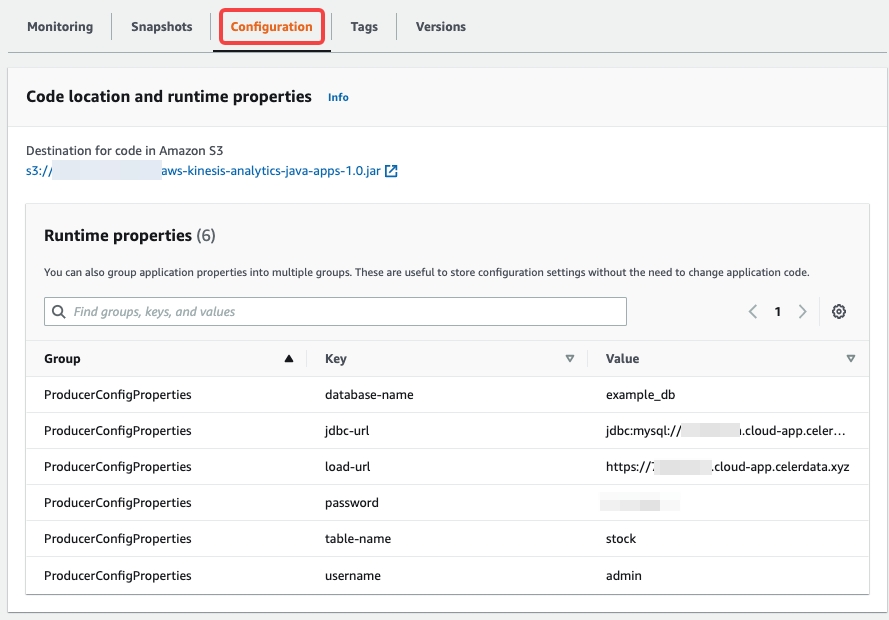
-
Add the flink-connector-starrocks dependency into the pom.xml file.
<dependency>
<groupId>com.starrocks</groupId>
<artifactId>flink-connector-starrocks</artifactId>
<version>1.2.6_flink-1.15</version>
</dependency>The flink-connector-starrocks version is in the format
${flink-connector-starrocks.version}_flink-${fink.version}_${scala.version}. And also, if the Flink version is 1.15.x, you do not need to specify the Scala version. For all the supported versions, see the github repo of flink-connector-starrocks. -
Compile and package the demo code into a JAR file. For more information, see Compile the application Code.
mvn package -Dflink.version=1.15.2 -
Upload aws-kinesis-analytics-java-apps-1.0.jar file to an Amazon S3 bucket. For more information, see Upload the Apache Flink Streaming Java Code.
Create and configure Kinesis Data Analytics application
Create and configure the Kinesis Data Analytics application according to the Create and Run the Kinesis Data Analytics application. Pay attention to the following configurations.
Configure IAM policy
Configure an IAM role that includes permissions required for the Kinesis Data Analytics application to read the data stream.
-
When you create a Kinesis Data Analytics application, create an IAM role with required policies by default.
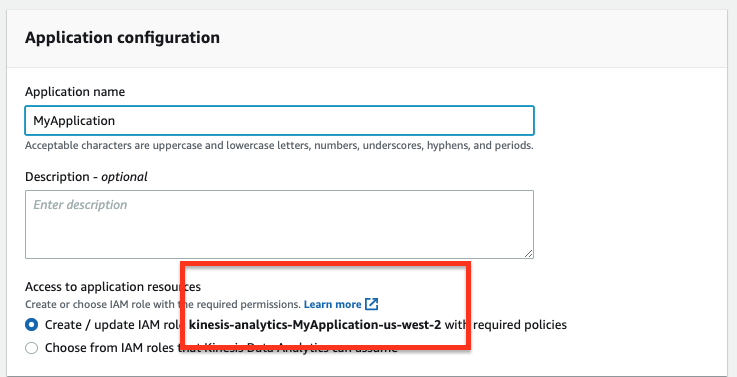
-
After you create the application, edit the IAM policies and make sure that the policy attached to the application is edited as follows: for the application. Note that you must replace the sample account ID
012345678901with your account ID.{
"Sid": "ReadInputStream",
"Effect": "Allow",
"Action": "kinesis:*",
"Resource": "arn:aws:kinesis:us-west-2:012345678901:stream/ExampleInputStream"
}
Configure application code location
When you configure the application, you need to provide the location of the application code:
-
For Amazon S3 bucket, specify the S3 bucket that contains the application JAR file.
-
For Path to Amazon S3 object, specify the name of the application JAR file. The default name is aws-kinesis-analytics-java-apps-1.0.jar.
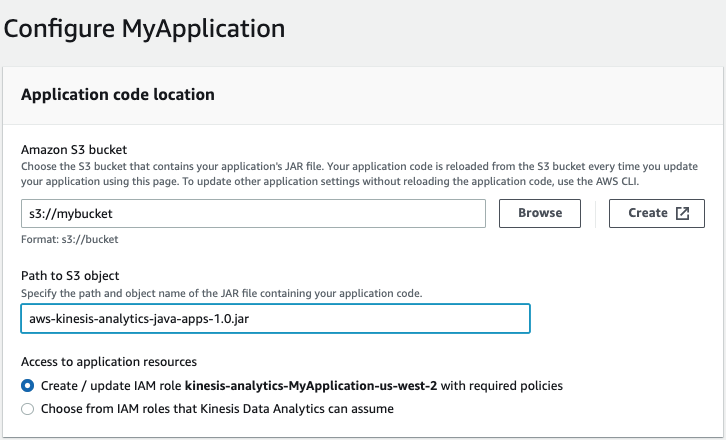
Configure application networking
-
When you configure the application, you need to configure networking to make sure the application has access to the Internet:
-
Option 1: Select Custom VPC configuration for VPC connectivity and select No VPC from the VPC drop-down list.
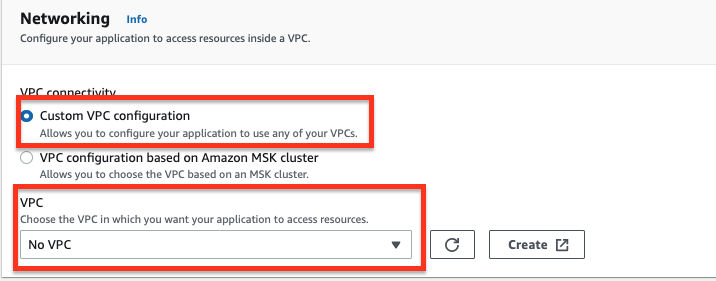
-
Option 2: Specify the networking by STRICTLY following the instructions provided in the Internet and Service Access for a VPC-Connected Kinesis Data Analytics application. In a nutshell, the application networking must meet the following requirements:
- The Kinesis Data Analytics application must run in a private subnet.
- The VPC must contain a NAT gateway or instance in a public subnet.
- A route is configured for outbound traffic from the private subnet that hosts the Kinesis Data Analytics application to the public subnet that hosts the NAT gateway or instance.
-
Run Kinesis Data Analytics application
-
On the MyApplication page, choose Run. In the message that appears, click Confirm.

-
In the Logs section of the Monitoring tab, view the running information. , such as Errors, Exceptions, Job status exceptions of the application to analyze errors and exceptions.
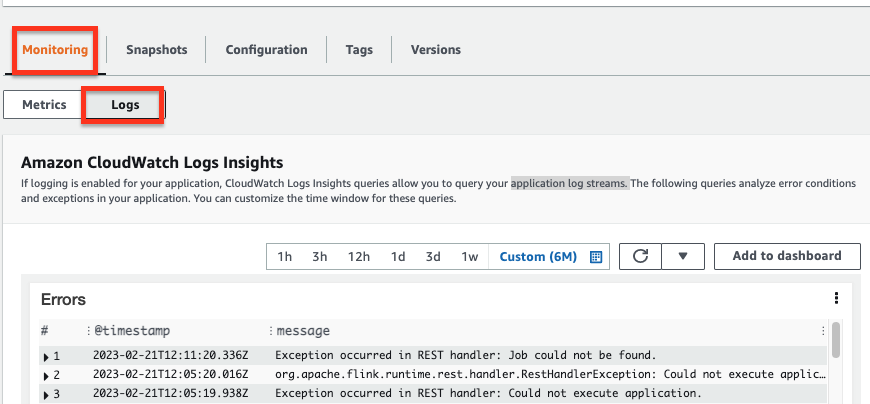
In the Logging and monitoring section of the Configuration tab, you can also view the application's
INFOorWARNlogs. You need to open the log stream kinesis-analytics-log-stream to search detailed logs by using event filters such asBasicStreamingJobandstarrocks.
FAQ
- Issue description: What do I do if the field throwableInformation shows
org.apache.flink.kinesis.shaded.com.amazonaws.SdkClientException: Unable to execute HTTP request : Connect to kinesis.us-west-2.amazonaws.com:443 [kinesis.us-west-2.amazonaws.com/34.223.45.1] failed: connect timed outin the Exceptions part of the Logs section of the Monitoring tab.
Possible causes: The Kinesis Analytics application is launched into a public subnet, instead of a private subnet.
Solutions:- If you customize the VPC for your application, check that the networking for the application must meet the following requirements:
- The Kinesis Data Analytics application must run in a private subnet.
- The VPC must contain a NAT gateway or instance in a public subnet.
- A route is configured for outbound traffic from the private subnet that hosts the Kinesis Data Analytics application to the public subnet that hosts the NAT gateway or instance. For more information, refer to Internet and Service Access for a VPC-connected Kinesis Data Analytics application.
- Or you can just configure the application networking as No VPC.
- If you customize the VPC for your application, check that the networking for the application must meet the following requirements:
- Issue description: What do I do if the field message shows
Error occurred when trying to start the joband the field throwableInformation shows thatFailed to get StarRocks versionin the Error part of the Logs section of the Monitoring tab.
Possible causes: Thejdbc-urlof your CelerData cluster is not correct.
Solutions: Usemysql -u <celerdata_domain_name> -P 9030 -uadminto test the connection to your CelerData cluster. - Issue description: What do I do if the field message shows
"message": "Failed to connect to address:``xxxxxxxxx.cloud-app.celerdata.com``”in the Exceptions part of the Logs section of the Monitoring tab.
Possible causes: Your application cannot access the domain of the CelerData cluster via the HTTPS protocol.
Solutions:
Check the following CelerData configuration:- The CelerData cluster has enabled the SSL connection.
- The security group associated with the celerdata cluster adds an inbound rule to open the port
443.